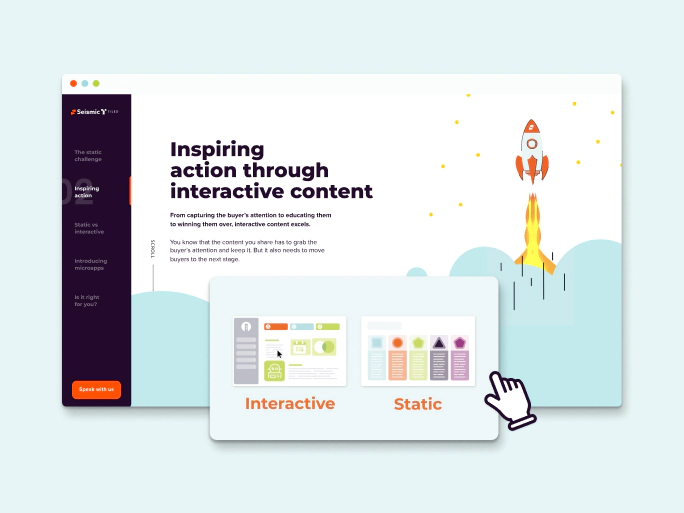What is content analytics?
Content analytics is the data and insights that offer a comprehensive view of how and when content is shared, who consumes it, and how it influences revenue. Content analytics provide organizations actionable insights to optimize content and workflows, enhance storytelling, and improve business outcomes.
Why is it important to track content performance?
Content performance data will help you identify areas that need improvement and show you where to shift your focus. After all, if a specific piece of content consistently outperforms another, using the more successful content can increase ROI. Here are just a few reasons why it’s beneficial to track content performance.
Identify most and least used content
Good content is one of the most powerful tools a company can have. When used correctly, it quickly builds trust between you and your consumers. By viewing your content, they should be able to glean all of the basic information about you that they need.
But how do you know whether or not your content is helpful? Identify the kind of content your reps are using, how they use it, and how often. It should contain information regarding the following topics:
- Who are you (as a business)?
- What do you do?
- What are your company values?
- What do you have to offer potential consumers?
- What makes you unique, and why should the audience be interested?
Determine how content is being used at each point of the deal cycle
If you have yet to perfect the art of the sales funnel, content analytics will help. It shows you how effective each type of content is relative to when you implement it. This will allow you to track patterns and pinpoint the optimal time to use different content pieces. You need this because even the best content can be ineffective if you time it wrong.
Understand how content influences deal progression
The main reason to use content analytics is to track what content is working ideally and how it impacts your business’s sales. If you are making content without tracking its performance, you may be putting time, money, and effort into something that is giving you minimal return. By keeping track of your content’s effects on deal progression, you can make sure that you only use content that benefits your business’s bottom line.
Uncover what type of content is missing from your organization
Content analytics does more than tell you which content is effective, which needs to be gotten rid of, and when to use it. It also helps indicate content opportunities that your business can use to improve sales and audience engagement.
Explore Interactive Content in Action

Content metrics to track
Content analytics can be used by every team within the organization. Marketers use content analytics to understand what content sellers use and how well it resonates with prospects. Sales reps can use content analytics to see how long buyers engage with content and use these insights to personalize their outreach. Sales and enablement leadership use content analytics to identify winning workflows and scale them across the organization.
So, how do they capture these insights? There are several key metrics that help go-to-market (GTM) teams capture a comprehensive picture of their activities. We’ll review each of them across the GTM lifecycle.
Content management metrics
Content management is the practice of collecting, maintaining, and publishing your organization’s content. Content analytics is a crucial component of content management, especially when tracking content freshness and what content reps are looking for.
- Content freshness: Content freshness is a term used to refer to how new, up-to-date, and relevant your content is. Stale content will not catch your target audience’s attention and, if it’s bad enough, can even discourage leads from doing business with you.
- Content searches: The right content management software can help you determine what content reps are looking for and whether they run searches that produce zero results. Tracking content searches will tell your marketing team which content is still relevant, must be updated, or can be done away with.
Content management is a big task and isn’t something that your employees can do manually or by hand. Implementing content management software is an investment that all businesses should make.
Content usage metrics
Before content is shared with prospects, it is first shared with sales reps. In order to create valuable content, marketers need to understand what’s popular with sellers. The following metrics will help you understand content usage:
- Downloads: How many times have sales reps downloaded content?
- Shares: How many times has an asset been shared by sales reps?
- Edits: Are sales reps modifying or updating content to personalize it for buyers?
- Uploads: Track how many new assets are created and added in a given period.
These metrics tell the story of how marketing and sales create and consume content. By understanding how and when sellers interact with content, marketers can work more efficiently and produce more of the content that sellers need.
Content engagement analytics
Buyers engage with content that helps them resolve their business challenges. The amount of time a prospect spends viewing content, as well as the links they click tells an important story. These insights allow for more meaningful conversations and help revenue teams determine how content influences opportunities. There are a handful of metrics that allow your GTM organization to measure engagement, but here are four types of analytics to start with:
- Average page views: How many pages do readers view after engaging with a specific piece of content
- Median view time: How engaging is the content you share with prospects? Measure content effectiveness by determining how much time is spent engaging with content.
- Engagement by sender: Identify the sellers that receive the highest engagement on the content they share with buyers.
- Engagement by content: Identify the content that yields the most engagement and drives more opportunities and deals.
By combining these metrics, your GTM team can begin to create a comprehensive picture of buyer engagement. When your team understands which content drives more views, the longest view times, and who generates the highest engagement, you can understand what resonates with your buyers and begin to scale best practices. You can also use these metrics to set benchmarks that your team can use to measure performance over time.
Content value and ROI
At the end of the day, content is only as valuable as its ability to create opportunities. In order to understand how valuable your content is, you need to understand how buyers engage with it throughout their journey.
Content by sales stage: Monitor the content that buyers engage with at different stages of their purchasing journey.
Content-influenced opportunities: At the end of a closed deal cycle, identify which content the buyer engaged with and whether it led to a closed-won or closed-lost opportunity.
Identifying where buyers engage with content during their purchasing journey helps determine when content is most effective and how it helps progress conversations. By understanding which content helped win or lose new business, your sales reps can use these insights to tailor their content experiences for future buyers.
The perks of using content tracking tools
Content analytics is a must-have for all businesses. Still, it can be daunting for smaller companies or those that are new to the concept. But what if it didn’t have to be? Content tracking software makes the process significantly easier and more efficient. Here are just a few things that content-tracking software can help you accomplish.
Pull data and reports for actionable insights
Content tracking tools offer many new and improved ways to gather, store, and organize data and content reports. These can then be used to fine-tune content usage strategies, pinpoint weak spots in your process, or identify any content you may be missing.
Share key data across the team
While having this information is a big step in the right direction, miscommunication, misplaced documents, and a lack of cohesion across teams can lead to significant setbacks for your company. Fortunately, content tracking software offers optimized ways to share data across teams and team members without it getting lost or misunderstood. It also gives them the ability to access it from any location at any time, in case they need access outside the office.
Dive into content data with Seismic
Now that you know why you need sales content analytics and content tracking software, where do you get it? Well, that’s simple. You can find all the content-related software you need through Seismic.
Seismic’s sales content analytics gives you a complete picture of prospect engagement, actionable insights, and a customizable dashboard to get your information delivered the way you want it. Want to see it in action? Click here!



